World Journal of Engineering and Technology, 2017, 5, 81-92
http://www.scirp.org/journal/wjet
ISSN Online: 2331-4249
ISSN Print: 2331-4222
Vision-Based Vehicle Detection for a Forward
Collision Warning System
Din-Chang Tseng, Ching-Chun Huang
Institute of Computer Science and Information Engineering, National Central University, Taiwan
How to cite this paper: Tseng, D.-C. and
Huang, C.-C. (2017) Vision-Based Vehicle
Detection for a Forward Collision Warning
System. World Journal of Engineering and
Technology, 5, 81-92.
https://doi.org/10.4236/wjet.2017.53B010
Received: July 11, 2017
Accepted: August 8, 2017
Published: August 11, 2017
Abstract
A weather-adaptive forward collision warning (FCW) system was presented
by applying local features for vehicle detection and global features for vehicle
verification. In the system, horizontal and vertical edge maps are separately
calculated. Then edge maps are threshold by an adaptive threshold value to
adapt the brightness variation. Third, the edge points are linked to generate
possible objects. Fourth, the objects are judged based on edge response, loca-
tion, and symmetry to generate vehicle candidates. At last, a method based on
the principal component analysis (PCA) is proposed to verify the vehicle can-
didates. The proposed FCW system has the following properties: 1) the edge
extraction is adaptive to various lighting condition; 2) the local features are
mutually processed to improve the reliability of vehicle detection; 3) the hie-
rarchical schemes of vehicle detection enhance the adaptability to various
weather conditions; 4) the PCA-based verification can strictly eli- minate the
candidate regions without vehicle appearance.
Keywords
Forward Collision Warning (FCW), Advanced Driver Assistance System
(ADAS), Weather Adaptive, Principal Component Analysis (PCA)
1. Introduction
To avoid the traffic accidents and to decrease injuries and fatalities, many ad-
vanced driving assistance systems (ADASs) have been developed paying more
regard to situations on road for drivers, such as forward collision warning
(FCW), lane departure warning (LDW), blind spot detection (BSD), etc. Based
on our previous studies [1] [2] [3], this study focuses on developing a FCW sys-
tem.
DOI: 10.4236/wjet.2017.53B010 Aug. 11, 2017
81
World Journal of Engineering and Technology
�
D.-C. Tseng, C.-C. Huang
DOI: 10.4236/wjet.2017.53B010
Extensive studies have been proposed for vision-based FCW systems [4] [5]
[6] [7]. Sun et al. [4] and Sivaraman et al. [5] generally divided the vision-based
vehicle detection methods into three categories: knowledge-based, motion-
based, and stereo-based methods. Knowledge-based methods integrate many
features of vehicles to recognize preceding vehicles in images. Most of these me-
thods are implemented by two steps: hypothesis generation (HG) and hypothesis
verification (HV) [4]. The HG step detects all possible vehicle candidates in an
image; the vehicle candidates are then confirmed by the HV step to ensure cor-
rect detections.
Due to the rigidness and the specific appearance of vehicles, many features
such as edges, shadow, symmetry, texture, color, and intensity can be observed
in images. The features used in knowledge-based methods can be further divided
into global features and local features according to whether the vehicle appear-
ance is considered when using the features. A usable FCW system should be sta-
ble in various weather conditions and in various background scenes. Further-
more, the system should get high detecting rate with fewer false alarms by uti-
lizing both local- and global features.
The weather adaptability of edge information is much better than other local
features such as shadow and symmetry. The contour of a vehicle can represent
by horizontal and vertical edges. However, the local edge features are not strict
enough to describe vehicle appearance. The appearance based verification is
better and need to support the vehicle detection based on edge information.
We here propose a FCW system combining the advantage of the global fea-
tures and local features to improve the reliability of vehicle detection. The local
feature is invariant to vehicle direction, lighting condition, and partial occlusion.
The global feature is used to search objects in the image base on whole vehicle
configuration. In the detection stage, all vehicle candidates are located according
to the local as many as possible to avoid missing targets; in the verification stage,
each candidate is confirmed as real target by the global as strictly as possible to
reduce the false alarms.
The proposed FCW system detects vehicles relying on edges; thereby the pro-
posed system can work well under various weather conditions. At first, the lane
detector [1] [2] is performed to limit the searching region of preceding vehicles.
Then an adaptive threshold is used to obtain bi-level horizontal and vertical
edges in the region. The vehicle candidate is generated depending on a valid ho-
rizontal edge and the geometry constrains vertical edges at two ends of the hori-
zontal edge. In verification stage, the vehicle candidates are verified by vehicle
appearance and principal component analysis (PCA). A principal component set
is obtained by applying PCA to a set of canonical vehicle images. These compo-
nents are used to dominate the appearance of vehicle-like regions; therefore, the
regions of vehicle-like objects can be well reconstructed by the principal com-
ponents. The closer the distance between an image and its reconstruction image
is, the higher the probability of the object on the image being a vehicle is.
82
World Journal of Engineering and Technology
�
D.-C. Tseng, C.-C. Huang
2. Vehicle Detection
Edge information is an important feature for detecting vehicles in an image, es-
pecially the horizontal edges of underneath shadows. In the detection stage, ve-
hicle candidates are generated based on local edge features. Firstly, the appropri-
ate edge points are extracted in the region of interest (ROI) defined by lane
marks as shown in Figure 1. Then, the significant horizontal edges indicating
vehicle locations are refined. The negative horizontal edges (NHE) are thought
belonging to underneath shadow. The positive horizontal edges (PHE) are
mostly formed by bumper, windshield and roof of vehicles. For each kind of ho-
rizontal edges with different property, a specific procedure to find vertical bor-
ders of vehicles is applied around each horizontal edge. Finally, the horizontal
edges and vertical borders are used to find the bounding boxes of vehicle candi-
dates.
The horizontal edges are expected belonging to underneath shadows or ve-
hicle body. Considering the sunlight influences, the horizontal edges belonging
to underneath shadows are further divided into the moderate or the long by edge
widths. The procedures for searching the paired vertical borders are designed
according to the specific properties of different kinds of horizontal edges. In the
proposed vehicle detection, three detecting methods (Case-1, Case-2, and Case-
3) are respectively designed to generate vehicle candidates based on the hori-
zontal edges of underneath shadows, long underneath shadows, and vehicle bo-
dies. In the situations of clear weather with less influence from sunlight, the un-
derneath shadows are distinct and the widths of shadows are similar to vehicle
width; Case-1 method proposed based on horizontal edges of moderate under-
neath shadows is adequately used to generate candidates. In the situations of
sunny weather with lengthened shadow, there is the strong possibility that only
one vertical border is searched by using Case-1 method; Case-2 method is pro-
posed based on horizontal edge of long underneath shadows to search two cor-
responding vertical borders in a larger region, as shown in Figure 2. In the situ-
ations of bad weather disturbed by water spray and reflection, the underneath
shadows are not reliable and are not observed at the worst; Case-3 method base
on vehicle bodies is applied in a different way to retrieve the missing cases of
using Case-1 and 2 methods.
If the only one vertical edge of the NHE is at the right side, it is taken as the
DOI: 10.4236/wjet.2017.53B010
Figure 1. Two examples of ROI setting based on the detected lane marks.
83
World Journal of Engineering and Technology
�
D.-C. Tseng, C.-C. Huang
Figure 2. An example of the vertical characteristics in a long
underneath shadow area.
right boundary of the window. The left boundaries of all windows are respec-
tively set at the x-positions which are 0.3 wlane to 0.8 wlane away from the right
boundaries, and vice versa. The symmetry of the vertical edge points in the
window is calculated by
symmetry
=
∑ ∑
h
j
1
=
w
/2
i
1
=
0.5
i
(
eng x y
,
w h
)
j
, (1)
where h and w are the height and the width of the window, xi and yj are the x-
and y-locations in the window, eng(xi, yj) is the energy of symmetry at (xi, yj) de-
fined by
eng x y
,
(
i
)
j
I
(
1, if
=
0,
x , y
i
otherwise
ep
)
=
I
(
x
w i
−
, y
j
ep
j
) 1
=
, (2)
where Iep(x, y) is the value of the edge point map Iep at (x, y) and Iep is one of the
vertical, the positive horizontal, and the negative horizontal edge point maps
which are Ivep, Ip_hep, and In_hep.
The horizontal edges in Case-3 are the edges of the vehicle body, though the
components which they belong to are unknown. The y-positions of the horizon-
tal edges can’t indicate the y-positions of the candidate bottoms, which only
gives a hint of the vehicle’s location. In the image, two vertical edges could be
detected at vehicle sides, which are similar to each other in length and y-posi-
tion. Therefore, two characteristic vertical edges are extracted from the areas
around two endpoints of the horizontal edge, respectively. The distance and the
y-position overlapping between two vertical edges are used to determine candi-
date bottom.
Firstly, the areas for searching the vertical edges are set extending upward and
downward from the horizontal edge endpoints, as the gray regions in Figure 3.
According to the candidate bottoms, the images of the vehicle candidates are
extracted with ratio height/width being 1. In the detecting result, the candidate
locations are represented by “U” shape bounding boxes. The bottom of a “U”
shape bounding box is the candidate bottom. The left and right margins of the
84
World Journal of Engineering and Technology
DOI: 10.4236/wjet.2017.53B010
�
D.-C. Tseng, C.-C. Huang
Figure 3. The searching areas for vertical edges and the long-
est vertical edges in each area.
bounding box are defined as the vertical line segments from (xl, yl) to (xl, yl +
w ) and from (xr, y(r)) to (xr, yr + w ), respectively. w is the width of the can-
didate bottom, that is w = xr – xl. Each horizontal edge is individually deter-
mined if it belongs to a vehicle candidate. Around one vehicle target, there might
be many bounding boxes which are set according to the horizontal edges at dif-
ferent y-positions. To delete the repetitions, the candidate being most closes to
the host vehicle in a candidate group is reserved for the rest processes. That is,
the bounding box with smallest y-position in image is reserved.
3. Vehicle Verification
In the verification stage, the vehicle candidates are determined applying PCA
reconstruction. The reconstruction images are obtained according to the images
of pre-trained eigenvehicles. Then, the image comparison methods are used to
evaluate the likelihood of the vehicle candidates to e vehicle.
3.1. The Principle and Procedure of PCA-based Verification
Principal components analysis (PCA) is a statistical technique used to analyze
and simplify a data set. Each principle component (eigenvector) is obtained with
a corresponding data variance (eigenvalue). The larger the corresponding va-
riance is, the more important the data information contained by the principle
component is. For application of reducing data dimensionality, the principle
components are sorted by the corresponding variance; and the original data are
projected onto the principle components with the largest m variance. PCA is
widely performed to image recognition and compression.
3.2. Eigenvehicle Generation
The images of the eigenvectors obtained by applying PCA to vehicle images are
called “eigenvehicles”. To generate a set of eigenvehicles, a training set of pre-
ceding vehicle images cropped from on-road driving videos are prepared. The
on-road driving videos are captured under various weather conditions; the
85
World Journal of Engineering and Technology
DOI: 10.4236/wjet.2017.53B010
�
D.-C. Tseng, C.-C. Huang
training images are collected with various vehicle types, in various distance far
from the own vehicle, and at the own/adjacent lane. The cropped images of pre-
ceding vehicles are firstly resized to 32 × 32. For each resized image, the edge
map is produced and then normalized by letting the sum of edge values being
equal to 1. The normalized edge maps as the training images are represented as
vectors Γ1, Γ2, …,and ΓM of size N, where M is the number of training images
and N = 32 × 32.
Only the leading eigenvehicles are applied in the verification of vehicle candi-
dates. The sixteen leading eigenvehicles with largest eigenvalues of all are shown
in Figure 4.
Eigenvehicles are easily influenced by background content, foreground size,
illumination variation, and imaged orientation. To solve most of the problems,
the original vehicle images of the training set are manually identified and seg-
mented fitting the contour. The color and illumination factors would be also
eliminated by using edge map and applying normalization to the edge map.
3.3. Evaluation by The Reconstruction Error
For each vehicle candidate, the original image is firstly resized to 32 × 32 and
transformed into a normalized edge map Γ. The edge map Γ subtracts the mean
image Ψ to have the difference, and the difference is then projected onto the M'
leading eigenvehicles. Each value representing a weight would be calculated by
iw
T
= u
i
G Y
( – ),
(3)
where i = 1, 2, …, M'. The reconstruction image
map Γ is then obtained by
Γˆ
of the normalized edge
ˆ
Γ
=
∑ u
w
i
i
M
'
i
1
=
+
Y
.
(4)
The vehicle space is the subspace spanned by the eigenvehicles, and the re-
construction image is the closest point to Γ on the vehicle space. The reconstruc-
tion error of Γ could be easily calculated by Euclidean distance (ED),
d
ˆ
Γ=
− Γ (5)
The reconstruction images are usually dusted by a lot of noises. For more ac-
ˆΓ , the comparing method should be more
curate comparison between Γ and
robust to noise and neighboring variations. The images could be regarded as 3D
models by taking the intensity at the image coordinate (x, y) to be the height of
DOI: 10.4236/wjet.2017.53B010
Figure 4. The top 16 eigenvehicles of the training set.
86
World Journal of Engineering and Technology
�
D.-C. Tseng, C.-C. Huang
the model bin (x, y). The 3D models can be compared to each other by a cross-
bin comparison measurement such as the quadratic-form distance [8], Earth
Mover’s Distance (EMD) [9], and the diffused distance (DD) method [10]. Earth
Mover’s Distance is calculated as
EM
D H
(
,
H
1
2
)
=
n
j
∑ ∑
∑ ∑
m
i
1
=
m
i
1
=
1
=
n
j
d f
ij
f
ij
1
=
ij
, (6)
where H1 and H2 are two compared histograms, fij is the work flow from bin i to
bin j, and dij is the ground distance between bins i and j. The diffused distance is
calculated by
(
K H H
,
1
)2
= ∑
L
l
=
0
d x
( )
l
,
(7)
where d0(x) = H1(x) – H2(x) and dl(x) = [dl–1(x) * φ (x, σ)] ↓2 are different lay-
ers of the diffused temperature field with l = 1, 2, …, L, φ (x, σ) is a Gaussian fil-
ter of standard deviation σ, and the notation “↓2“ denotes half size down- sam-
pling.
The recognition abilities of ED, EMD, and DD can be compared by receiver
operating characteristic (ROC) curves to decide the appropriate measurement
for the proposed vehicle verification, as shown in Figure 5. There are 500 posi-
tive and 500 negative samples used to evaluate each ROC curve. The ROC curves
are plotted with the false positive rate in x-axis and the true positive rate in y-
axis by changing the threshold of judging a sample as a vehicle. The statistics of
positive and negative samples measured using ED, EMD and DD are shown in
Figure 6. The x-axis is the measured distance and the y-axis is the accumulation
of samples. The threshold of measured distance is changed in the statistics from
minimum to maximum distance values to calculate the ratio of positive and
negative samples being recognized as a vehicle.
The verification based on PCA reconstruction is deeply influenced by the
DOI: 10.4236/wjet.2017.53B010
Figure 5. The ROC curves of the distance measurements: ED, EMD, and
DD.
87
World Journal of Engineering and Technology
�
D.-C. Tseng, C.-C. Huang
0.08
0.06
0.04
0.02
0
0.08
0.06
0.04
0.02
0
0.08
0.07
0.06
0.05
0.04
0.03
0.02
0.01
0
0.0
0.2
0.4
0.8
1.0
0.6
(a)
0.0
0.2
0.4
0.8
1.0
0.6
(b)
0.0
0.2
0.4
0.8
1.0
0.6
(c)
Veh
non-Veh
Veh
non-Veh
Veh
non-Veh
Figure 6. The measurement statistics of positive and negative
samples using three methods. (a) ED; (b) EMD; (c) DD.
number of used eigenvehicles. The distance between the original image and re-
construction image decreases with the increment of the eigenvehicle number;
however, the execution time of projecting and reconstructing linearly increases
with the increment of the eigenvehicle number. According to our analysis, the
distance decrement is obviously slowdown when the eigenvehicle number is
larger than 50. It is important to consider that is the time cost of using eigenve-
hicles more than 50 worth enough for the PCA-based verification. The verifica-
tion ability of the PCA-based method can be analyzed by ROC curves. The vari-
ation of the area ratio under the ROC curves shows the limitation of improving
reconstruction difference by increasing the eigenvehicle number. Depending on
the application, a suggestion of the eigenvehicle number is 40 - 80.
4. Experiment and Discussions
The proposed FCW system has been tested with the videos captured under var-
ious weather conditions and environment situations: sunny day (S), cloudy day
(C), long shadow (LS), facing sun ray (FS), rainy day (R), heavily rainy day
(HR), etc.
88
World Journal of Engineering and Technology
DOI: 10.4236/wjet.2017.53B010
�

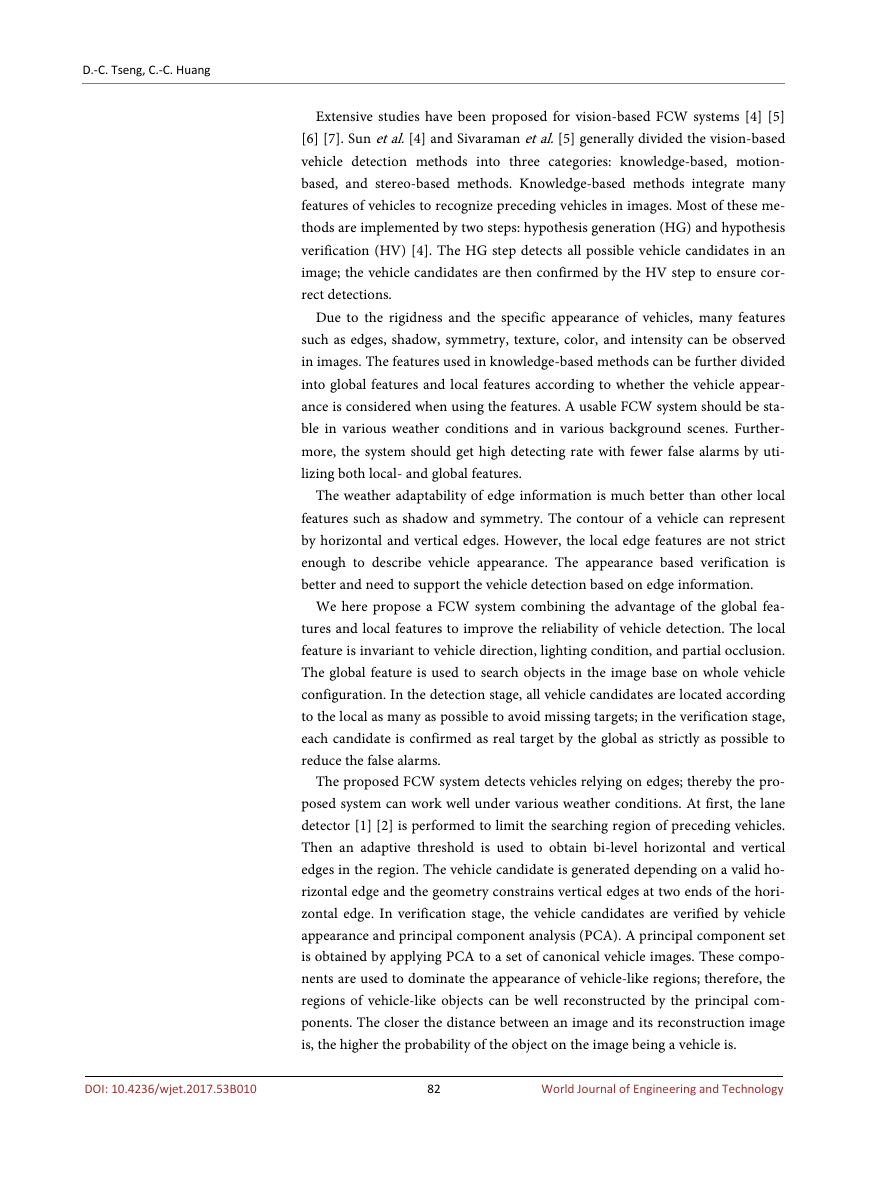
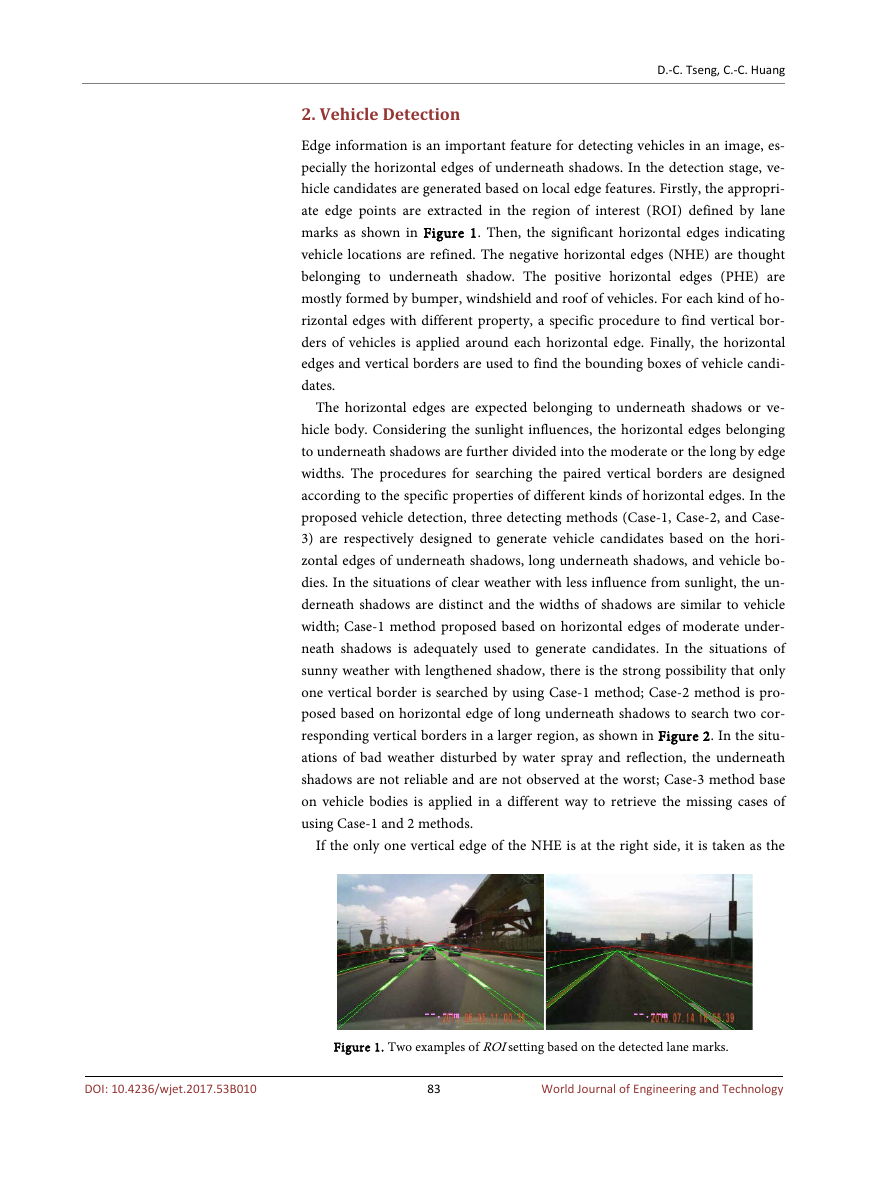

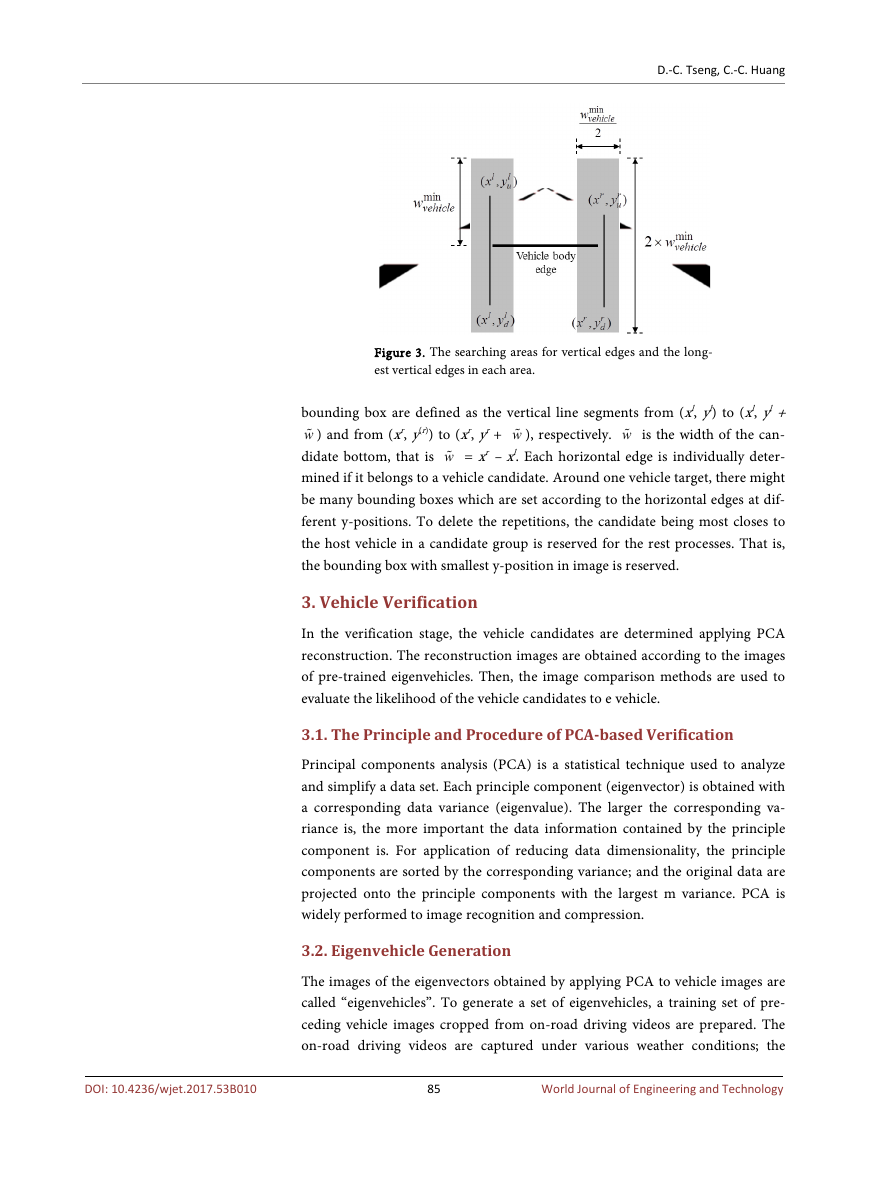
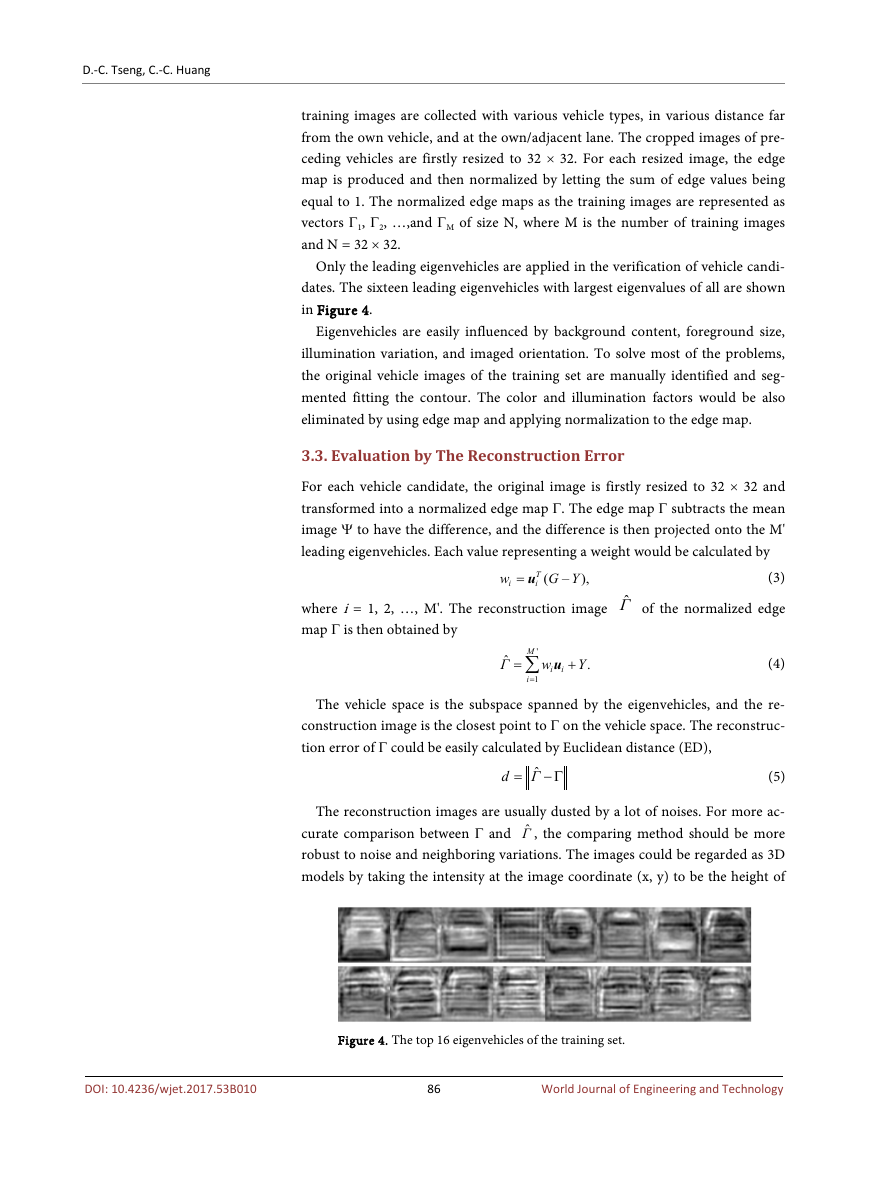
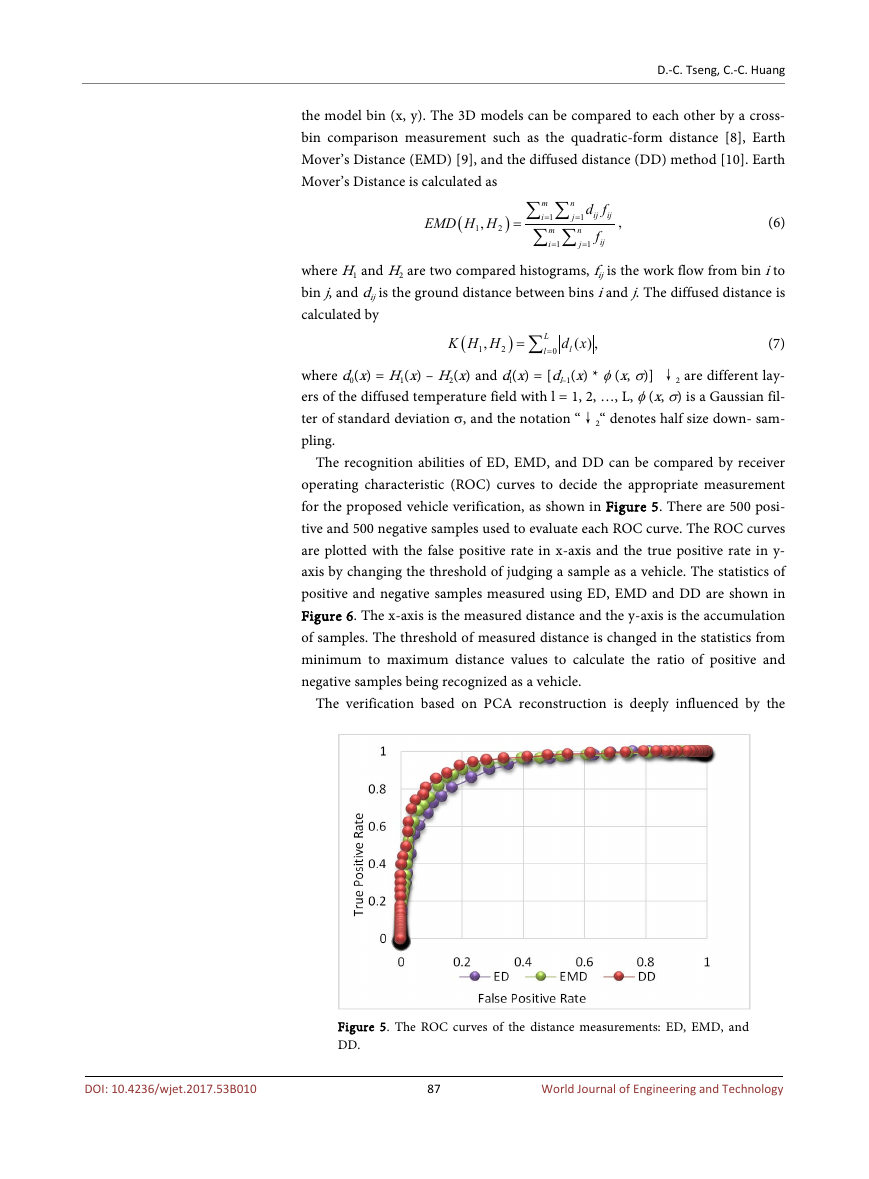
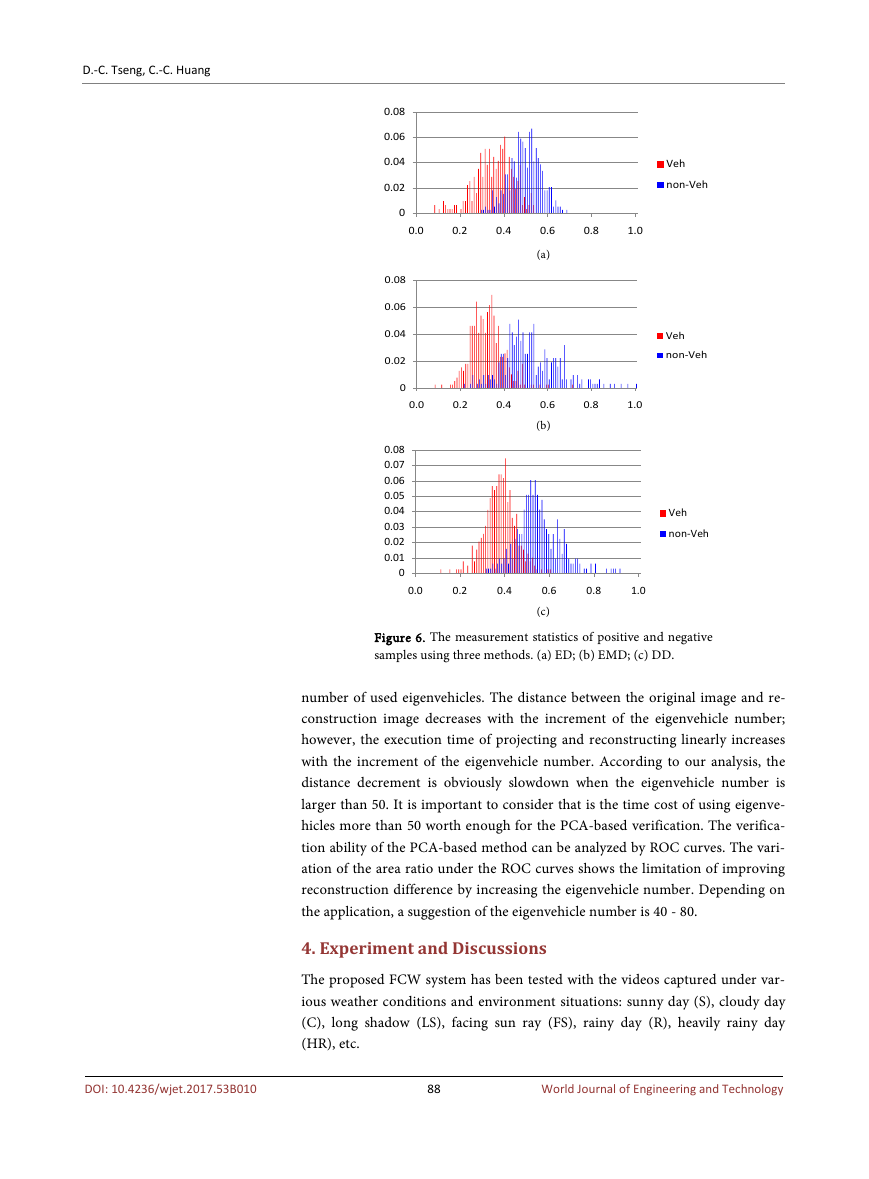








 2023年江西萍乡中考道德与法治真题及答案.doc
2023年江西萍乡中考道德与法治真题及答案.doc 2012年重庆南川中考生物真题及答案.doc
2012年重庆南川中考生物真题及答案.doc 2013年江西师范大学地理学综合及文艺理论基础考研真题.doc
2013年江西师范大学地理学综合及文艺理论基础考研真题.doc 2020年四川甘孜小升初语文真题及答案I卷.doc
2020年四川甘孜小升初语文真题及答案I卷.doc 2020年注册岩土工程师专业基础考试真题及答案.doc
2020年注册岩土工程师专业基础考试真题及答案.doc 2023-2024学年福建省厦门市九年级上学期数学月考试题及答案.doc
2023-2024学年福建省厦门市九年级上学期数学月考试题及答案.doc 2021-2022学年辽宁省沈阳市大东区九年级上学期语文期末试题及答案.doc
2021-2022学年辽宁省沈阳市大东区九年级上学期语文期末试题及答案.doc 2022-2023学年北京东城区初三第一学期物理期末试卷及答案.doc
2022-2023学年北京东城区初三第一学期物理期末试卷及答案.doc 2018上半年江西教师资格初中地理学科知识与教学能力真题及答案.doc
2018上半年江西教师资格初中地理学科知识与教学能力真题及答案.doc 2012年河北国家公务员申论考试真题及答案-省级.doc
2012年河北国家公务员申论考试真题及答案-省级.doc 2020-2021学年江苏省扬州市江都区邵樊片九年级上学期数学第一次质量检测试题及答案.doc
2020-2021学年江苏省扬州市江都区邵樊片九年级上学期数学第一次质量检测试题及答案.doc 2022下半年黑龙江教师资格证中学综合素质真题及答案.doc
2022下半年黑龙江教师资格证中学综合素质真题及答案.doc